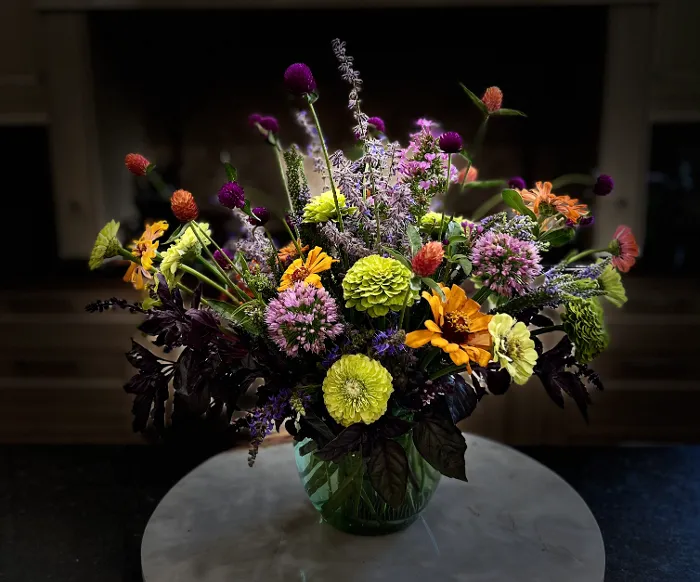Using Backyard Flowers to Make Arrangements: The Basics

Disclosure: Some of the links in this article may be affiliate links, which can provide compensation to me at no cost to you if you decide to purchase. As an Amazon associate I may earn from qualifying purchases
Gardening is a wonderful hobby that allows you to connect with nature and create stunning displays of beauty in your own backyard. Among the many joys of gardening, arranging flowers is an art that can bring life and color into your indoor spaces.
In this blog, we'll guide you through the step-by-step basics of floral arranging that the average person can understand and follow. So, let's get started on your journey to becoming a flower arranging enthusiast!
Step 1: Gather Your Materials:
Before you begin arranging flowers, gather the necessary materials. Here's what you'll need:
1. Flowers: Choose a variety of flowers with different colors, shapes, and textures. You can either pick them from your garden or purchase them from a local florist or market.
2. A clean vase or container: Select a vase or container that complements the size and style of your arrangement. Make sure it's clean and filled with fresh water.
3. Floral foam, frog or floral tape: Use floral foam (also known as Oasis) or floral tape to hold the flowers in place within the vase. Floral foam is ideal for more complex arrangements, while floral tape or the frog works well for simpler designs. If your vase has a smaller opening, you may not need these to hold the flowers in place.
4. Pruning shears or sharp scissors: These will help you trim the stems and remove any excess foliage.
Step 2: Prepare the Flowers:
To ensure your flowers last longer and look their best, follow these preparation steps:
1. Trim the stems: Using pruning shears or sharp scissors, cut the stems at an angle. This allows better water absorption. Remove any leaves that will be submerged in the water.
2. Hydrate the flowers: Place the cut stems in a bucket of clean water right after you cut them. You can leave them in there for a few hours before arranging them. This step helps rehydrate the flowers and ensures their longevity.
3. Choose a color scheme:
Monochromatic schemes show off a variety of different hues of the same color.
mostly green color monochromatic scheme
mostly red flowers creating a monochromatic scheme
Complimentary colors can result in a dynamic and eye-catching display. These colors are usually opposite each other on the color wheel. (Yellow and violet, Blue and orange, Red and green)
Complimentary colors of yellow and violet
Analogous colors are hues that sit adjacent to each other on the color wheel. These colors blend well together and create a sense of harmony and unity. (red, orange yellow),(blue, green, teal)(purple, pink, red)
Analogous colors of Yellow, Red and Orange
Triadic color schemes involve three colors that are evenly spaced on the color wheel. This combination creates a vibrant an well-balanced arrangement. (Yellow, blue, and red), (Orange, green, and violet)
Triadic colors of orange, green and violet
Triadic colors: orange, green and violet
Step 3: Designing Your Arrangement:
Now it's time to let your creativity shine. Follow these guidelines to design your flower arrangement:
1. Start with greenery: Begin by adding foliage or greenery to your vase. This provides a base and adds volume to your arrangement. Arrange the greenery in a circular or triangular shape, depending on the size of your vase.
2. Add focal flowers: Select one or two standout flowers to serve as the focal point of your arrangement. Place them in the center or slightly off-center to create visual interest.
3. Build layers: Gradually add flowers of varying heights and shapes around the focal flowers. Use odd numbers for a more pleasing arrangement. Place taller flowers towards the back and shorter ones towards the front. Make sure to distribute colors evenly for a balanced look.
4. Fill in gaps: Fill any gaps with smaller filler flowers, such as baby's breath or statice. I have even used the flowers of a dill as filler. These delicate blooms add texture and fill out the arrangement.
5. Step back and assess: Regularly step back and evaluate your arrangement from different angles. Make adjustments as needed to ensure a well-balanced and visually appealing composition.
Step 4: Maintenance and Longevity:
To keep your arrangement looking fresh and vibrant, follow these maintenance tips:
1. Change the water: Every two to three days, replace the water in the vase with fresh, room temperature water. This helps prevent bacterial growth and keeps the flowers hydrated. I use a flower preservative in the water for long lasting arrangements.
2. Trim the stems: Every few days, trim the stems by a few centimeters. This allows the flowers to continue absorbing water efficiently.
3. Remove wilted flowers: As flowers start to fade, remove them from the arrangement. This helps maintain the overall appearance and prolongs the life of the remaining flowers.
Conclusion:
Flower arranging is an accessible and enjoyable activity that anyone can master with a little practice and creativity. By following this basic step-by-step guide outlined in this blog, you can create stunning floral arrangements that bring joy and beauty into your home or special occasions. Remember to experiment with different flower combinations, have fun, and let your artistic flair blossom.
Happy flower arranging!
Related articles:
Preserving Peony Flowers: The Marshmallow Bud Hack
https://inthegardensue.com/blog/preserving-peony-flowers-the-marshmallow-bud-hack
10 Common Mistakes when Growing Dahlias
https://inthegardensue.com/blog/10-common-mistakes-to-avoid-when-growing-dahlias
19 Shallow Rooted Plants for Your Raised Beds
https://inthegardensue.com/blog/19-shallow-rooted-plants-for-your-raised-beds
Create A Wildflower Meadow: Our Simple Guide
https://inthegardensue.com/blog/create-a-wildflower-meadow-our-simple-guide
Disclosure: Some of the links in this article may be affiliate links, which can provide compensation to me at no cost to you if you decide to purchase. As an Amazon associate I may earn from qualifying purchases






